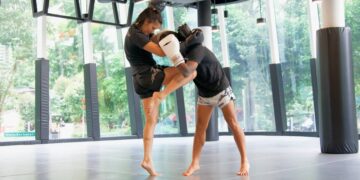In Brazilian Jiu-Jitsu, understanding and mastering timing can elevate your grappling from good to great. This involves more than quick reactions if you think about it. It requires anticipation, strategy, and an understanding of the most common reactions. This article will discuss the significance of timing and its practical applications for both the offensive and defensive end in BJJ.
What Is Timing In BJJ?
Timing in BJJ refers to the ability to execute a move or counter at the most suitable moment. It involves anticipating an opponent’s actions and responding at the right time to maximize effectiveness and minimize effort. Good timing allows you to leverage your opponent’s momentum, positioning, and even distractions to gain a small advantage. It’s not just about speed; it’s about choosing the right moment to act, which can make techniques more effective and help improve your positional dominance wherever the match goes.
The Importance Of Timing In BJJ
Timing in Jiu-Jitsu is a key element that determines how well you control the pace and dynamics of a match. It allows you to not only respond appropriately to your opponents’ actions but also anticipate and prepare for them. This anticipation helps in setting up defenses or preparing counterattacks more effectively. Additionally, timing plays a crucial role in energy conservation during matches. Knowing when to exert maximum effort and when to conserve energy helps maintain stamina, especially in tournament settings where matches can be lengthy and against formidable opponents. Effective timing enables you to utilize your energy efficiently, helping you maintain optimal performance throughout a bout.
Strategies For Improving Timing
To improve your timing, you must engage in various activities that hone both physical and mental quickness. Regular drilling of techniques is obviously required, as it helps drill down movements into muscle memory, allowing for automatic and timely execution during sparring or competition. Controlled sparring sessions are also important; they simulate real combat scenarios and provide a platform to practice timing against an active, resisting opponent. Starting with slower, deliberate exchanges and gradually increasing the pace can adapt to real-match conditions. Proactively learning from seasoned grapplers, either through live watching or video analysis, also helps in understanding how to time moves effectively. Taking note of how experienced practitioners like Gordon Ryan, Dante Leon, and other top-performing BJJ athletes manage their timing can offer valuable strategic insights applicable to both training and competition.
Practical Applications Of Timing In BJJ
Timing impacts every aspect of grappling. In takedowns, good timing involves using an opponent’s momentum against them, allowing for smoother and more effective execution. When passing guards, recognizing the moment your opponent is vulnerable (such as during their transitions or adjustments), can provide an opening to advance your position. Timing is crucial in setting up submissions as well; a submission attempt should overlap with moments when an opponent’s weakness is most exposed, such as when they are attempting an escape or trying to adjust their position. Also, timing escapes require acute awareness of the opponent’s movements; capitalizing on a momentary lapse in their pressure or focus can enable a successful escape.
Tradeoff Between Timing And Technique In BJJ
While technique forms the base of our grappling knowledge, timing is one of the key ingredients that determines the effectiveness of these techniques in actual scenarios. Understanding and managing the tradeoff between perfecting a technique and executing it at the right moment is crucial for any BJJ practitioner.
Execution of a technique in BJJ requires precise movements and a detailed understanding of mechanics and body positioning. That being said, a technique may still fail without the right timing. For example, a technically excellent armbar is useless if applied too early or too late, when the opponent is prepared or has already moved into a defensive position. On the other hand, even a less refined technique can be highly effective if executed at an opportune moment when the opponent is vulnerable or off-balance (Kuzushi).
To effectively manage the tradeoff between timing and techniques, practitioners must train in environments that promote both skill sets. This training includes scenario-based drilling where techniques are practiced under different pressures and timings, as well as live sparring sessions that mimic the unpredictability of real competitions. Feedback from coaches and fellow grapplers is also invaluable in refining the ability to gauge when to prioritize timing over perfect technique and vice versa.
Adding Timing To Your Overall Game
Incorporating timing into your BJJ game is a smart idea that significantly elevates your performance. Adding timing involves more than just learning when to execute moves, as it also develops a good sense of awareness and responsiveness that complements your basic technical skills.
Specific drills can enhance your timing, such as reactive drills where you respond to your training partner‘s actions rather than initiate your own. These drills help you practice the quick decision-making process needed to capitalize on quick opportunities during sparring sessions or matches. For example, you might work on escaping submissions as soon as you feel your opponent adjust their grip, or you might practice passing the guard at the moment your partner repositions their legs.
Finally, try to become more mindful of your timing when you roll. Don’t focus only on getting that submission. A better approach is to fine-tune your technique and timing every time you train so that you consistently level up your overall grappling.
Conclusion
Mastering timing in BJJ is more than simply exploding in and out of positions, it’s about strategic anticipation and execution. Timing is essential in both conserving energy during matches and exploiting moments of opportunity. Effective timing is in many cases, a complex skill that requires a deep understanding of the art.
By focusing on the strategies discussed and continuously applying them in training and competition, you can greatly enhance your ability to use timing to your advantage, leading to more successful and controlled grappling outcomes.
Remember the old adage that goes: “Slow is smooth, and smooth is fast”. Moving at the right place and the right time is always the best way to develop a smooth and uncompromising game.
You may also like:
The Turtle Fortress And Turtleplata In BJJ
Brazilian Jiu-Jitsu is a martial art that thrives on both offensive and defensive techniques. The turtle is considered as one of the premier positions in the art and is known as a tough position to…
The world of Brazilian Jiu-Jitsu is filled with many unique techniques and positions. One of the things that set BJJ apart from other grappling arts is the fact that Jiu-Jitsu allows more freedom to fight…
Starting Brazilian Jiu-Jitsu can be both exciting and overwhelming. With so many techniques, positions, and submissions to learn, it’s easy to feel lost or forget what you’ve practiced during class. However, remembering techniques doesn’t have…
Canada is home to great fighters and martial artists like Rory Macdonald, Carlos Newton, and Georges St-Pierre. Over the past couple of years, Canada has been slowly climbing its way to the top of the…
Over the years, America has become a powerhouse of grappling. Brazilian Jiu-Jitsu stars like Mikey Musumeci, brothers Tye and Kade Ruotolo, Dorian Olivarez, Helena Crevar, and Cole Abate are all proud competitors representing the USA….
Every sport operates in cycles. Every timeline has its end and beginning. As a new dawn starts, a superstar is always born to take the lead toward the quest for greatness. Gordon Ryan is currently…
Sweeps are some of the highest-scoring techniques in Muay Thai. Knocking an opponent’s legs out from under them and sending them crashing to the canvas requires exceptional timing and skill. The mere sight of you…
When working out, building significant muscle mass takes dedication, hard work, and time, so you want to do everything possible to maintain your new physique. The last thing you want is for your newly gained…
Signing up for martial arts like Muay Thai, Brazilian Jiu-Jitsu (BJJ), and Boxing helps you to lose weight in more ways than one. Engaging in intense exercise, such as martial arts training, provides a significant…
In Singapore’s ever-busy and fast-paced urban landscape, sleep often feels like a luxury rather than a necessity. While much of the city’s energy is fueled by ambition and productivity, sleep deprivation has quietly become an…
Fans of ONE Championship’s Friday Fights at Lumpinee Stadium will be familiar with the name Nabil Anane. Standing at 192 cm, the Thai-Algerian is not only one of the tallest fighters in the ONE arena…
The front snap kick has been used in mixed martial arts (MMA) since its early days. Royce Gracie often peppered opponents with it to set on his takedowns on this way to winning three of…


































